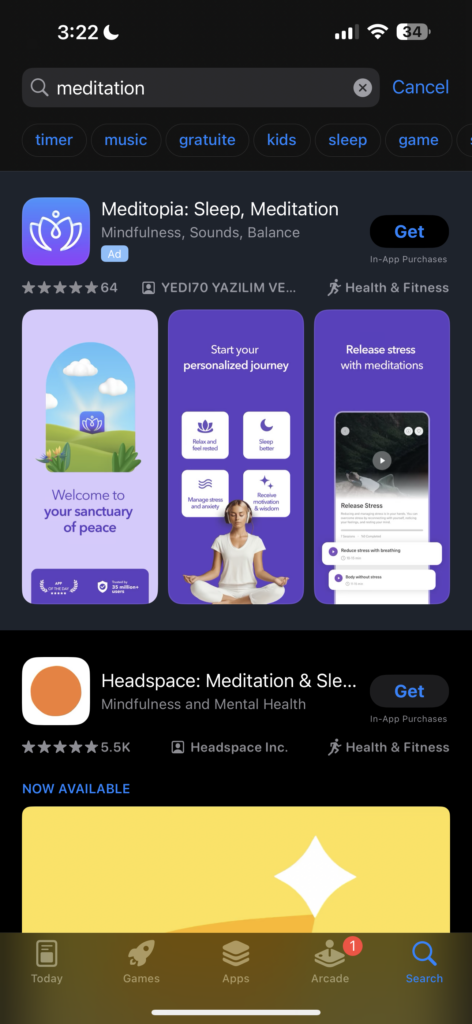Key Takeaways
- Optimize App Visibility: Master ASO keyword research to select relevant keywords, enhancing your app’s visibility in crowded app stores.
- Track Performance Metrics: Monitor key metrics like search volume, competition, and user engagement to refine your keyword strategy and drive downloads.
- Continuous Optimization: ASO keyword research is an ongoing process. Stay agile, adapt to changes in algorithms, and iterate on your keyword strategy to maintain app success.
In the ever-expanding digital landscape, where mobile applications reign supreme, securing visibility amidst the multitude of offerings is paramount for app developers and marketers alike.
As the competition intensifies, mastering the art of App Store Optimization (ASO) becomes not just a choice but a necessity.
At the core of effective ASO lies meticulous keyword research, a process that involves identifying and targeting the right keywords to enhance an app’s discoverability and drive downloads.

Welcome to our comprehensive guide on ASO Keyword Research, where we delve deep into the intricacies of this vital aspect of app marketing.
Whether you’re a seasoned app developer looking to fine-tune your strategies or a newcomer seeking to understand the nuances of ASO, this article is crafted to equip you with the knowledge and insights needed to navigate the dynamic landscape of app store rankings.
In this journey through ASO Keyword Research, we’ll explore the key metrics that hold the key to success in optimizing your app’s presence on the app stores.
From understanding the relevance of keywords to deciphering search volume, competition, and difficulty metrics, we leave no stone unturned in uncovering the factors that can make or break your app’s visibility.
But why is ASO keyword research so crucial?
Imagine your app as a needle in a haystack, buried amidst millions of other offerings. Without the right keywords, your potential users may never find you, no matter how innovative or useful your app may be.
ASO keyword research acts as a compass, guiding users towards your app by ensuring it appears in relevant search results and categories.
In this era of information overload, users rely heavily on search queries to discover new apps. Whether they’re seeking a productivity tool, a gaming sensation, or a lifestyle companion, their journey often begins with a simple search.
By optimizing your app with the right keywords, you not only increase its visibility but also attract users who are actively seeking what your app has to offer.
Thus, ASO keyword research serves as the cornerstone of a successful app marketing strategy, enabling you to connect with your target audience in a crowded marketplace.
However, embarking on the journey of ASO keyword research can be daunting without a clear roadmap.
With countless metrics to consider and algorithms to decipher, it’s easy to feel overwhelmed.
Fear not, for this guide is designed to demystify the process and empower you with actionable insights.
Throughout this article, we’ll not only explore the theoretical aspects of ASO keyword research but also provide practical tips, tools, and case studies to illustrate how these concepts translate into real-world success.
Whether you’re optimizing your app for the Apple App Store, Google Play Store, or any other platform, the principles of ASO keyword research remain universal, making the knowledge you gain here invaluable across various app ecosystems.
So, if you’re ready to unlock the full potential of your app and propel it to new heights of success, join us on this journey through the intricate world of ASO keyword research.
Together, let’s unravel the mysteries, decode the algorithms, and pave the way for your app to stand out amidst the noise and captivate your audience’s attention. The path to app success begins here, with ASO keyword research as your trusted guide.
ASO Keyword Research: The Key Metrics You Need to Track for Success
- Understanding ASO Keyword Research
- Key Metrics in ASO Keyword Research
- Best Practices for ASO Keyword Research
1. Understanding ASO Keyword Research
In the realm of App Store Optimization (ASO), keyword research serves as the bedrock upon which successful app marketing strategies are built.
Understanding the nuances of ASO keyword research is essential for app developers and marketers seeking to enhance their app’s visibility and drive downloads. Let’s delve deep into this fundamental aspect of ASO:
Definition of ASO Keyword Research
- ASO keyword research involves identifying and targeting the most relevant keywords and phrases that users are likely to search for when looking for apps similar to yours.
- It’s a strategic process aimed at optimizing your app’s metadata, including the app title, subtitle, description, and keywords field, to improve its visibility in app store search results.
- By incorporating the right keywords into your app’s metadata, you increase the likelihood of it appearing in relevant search queries, thereby attracting organic traffic and potential users.

Importance of ASO Keyword Research
- Enhanced Visibility: Proper keyword optimization increases your app’s chances of ranking higher in app store search results, ensuring it’s more visible to potential users.
- Targeted Traffic: By targeting specific keywords related to your app’s features, functionality, and target audience, you attract users who are actively searching for apps like yours, leading to higher-quality traffic and increased conversions.
- Competitive Advantage: Effective ASO keyword research allows you to identify niche keywords with lower competition, providing you with a competitive edge in crowded app categories.
- Long-Term Sustainability: Unlike paid advertising campaigns, which cease to generate traffic once the budget is exhausted, ASO keyword optimization can drive sustainable organic traffic to your app over the long term, maximizing your ROI.
How ASO Keyword Research Differs from Traditional SEO Keyword Research
- Platform-Specific Considerations: ASO keyword research takes into account the unique algorithms and ranking factors of each app store platform, such as the Apple App Store and Google Play Store.
- Focus on App Metadata: While traditional SEO focuses on optimizing web content such as articles and blog posts, ASO keyword research primarily revolves around optimizing app metadata, including titles, descriptions, and keywords.
- User Intent: ASO keyword research places greater emphasis on understanding user intent within the context of app discovery and download, as opposed to broader search intent in traditional SEO.
Examples:
- Traditional SEO Keyword: “Best Italian Restaurants in New York”
- ASO Keyword Equivalent: “Italian Restaurant Finder App New York”
- Explanation: While a traditional SEO keyword targets users looking for information about Italian restaurants, an ASO keyword targets users actively seeking a mobile app to help them find Italian restaurants in New York.
By grasping these fundamental concepts of ASO keyword research, you lay the groundwork for developing a robust app marketing strategy that maximizes your app’s visibility, drives targeted traffic, and ultimately leads to increased downloads and user engagement.
2. Key Metrics in ASO Keyword Research
Relevance
Ensuring the relevance of your chosen keywords is paramount in ASO keyword research.
Relevance determines how well your app aligns with user search queries, directly impacting its visibility and ultimately, its success in app stores.

Let’s delve into the importance of relevance metrics and how to optimize them effectively:
Importance of Relevance Metrics
- Alignment with User Intent: Relevance metrics ensure that your app appears in search results that closely match what users are looking for, increasing the likelihood of attracting qualified traffic.
- Enhanced User Experience: Targeting relevant keywords improves the user experience by guiding users to apps that meet their specific needs and preferences.
- Higher Conversion Rates: When users find apps that are relevant to their search queries, they are more likely to engage with the app’s listing and ultimately download it, leading to higher conversion rates.
Metrics to Assess Relevance
- Keyword-App Fit: Evaluate how well your chosen keywords align with your app’s features, functionality, and target audience.
- User Search Behavior: Analyze user search queries and behavior to identify keywords that reflect popular search trends and user intents.
- Competitor Analysis: Assess the relevance of your keywords by analyzing the keywords used by top-ranking competitors in your app category.
Optimization Strategies
- Keyword Selection: Choose keywords that accurately describe your app’s main features, functions, and benefits. Avoid generic or overly broad keywords that may attract irrelevant traffic.
- App Metadata Optimization: Optimize your app’s metadata, including the title, subtitle, description, and keywords field, with relevant keywords that reflect its core features and value proposition.
- User Feedback Integration: Incorporate user feedback, reviews, and ratings to identify keywords that resonate with your target audience and address their specific needs and preferences.
- Continuous Monitoring and Refinement: Regularly monitor keyword performance metrics and user engagement to identify opportunities for optimization and refinement. Adjust your keyword strategy based on changes in user behavior and market trends.
Example:
Suppose you have a meditation app that offers guided meditation sessions for stress relief. Relevant keywords for this app may include “stress relief meditation,” “guided meditation for relaxation,” and “mindfulness meditation app.”
By targeting these keywords, you ensure that your app appears in search results when users are actively seeking solutions for stress relief through meditation practices.

By prioritizing relevance metrics in your ASO keyword research, you can optimize your app’s visibility, attract qualified traffic, and ultimately drive downloads and user engagement.
Continuously refining your keyword strategy based on relevance metrics ensures that your app remains competitive and resonates with your target audience in the ever-evolving landscape of app stores.
Search Volume
Understanding search volume metrics is crucial in ASO keyword research as it indicates the demand and popularity of specific keywords among users.
By analyzing search volume data, app developers can identify high-demand keywords to target, increasing their app’s visibility and potential downloads.
Let’s explore the significance of search volume metrics and strategies for optimizing them effectively:
Importance of Search Volume Metrics
- Demand Assessment: Search volume metrics provide insights into the popularity and demand for specific keywords among users. Higher search volumes indicate greater demand, presenting opportunities for increased app visibility.
- Traffic Potential: Keywords with higher search volumes have the potential to attract more organic traffic to your app listing, increasing the likelihood of downloads and user engagement.
- Competitive Advantage: Targeting keywords with high search volumes allows you to compete effectively for visibility in app store search results, especially in competitive app categories.

Metrics to Assess Search Volume
- Monthly Search Volume: Analyze the average number of searches performed for a specific keyword within a given timeframe, typically monthly.
- Trend Analysis: Monitor search volume trends over time to identify seasonal fluctuations, emerging trends, and long-term patterns in user search behavior.
- Comparative Analysis: Compare search volumes for different keywords to prioritize those with the highest demand and potential for driving traffic to your app.
Optimization Strategies
- Keyword Research: Utilize ASO tools and platforms to conduct keyword research and identify keywords with high search volumes relevant to your app’s features and target audience.
- Long-Tail Keywords: Explore long-tail keywords that may have lower search volumes but are more specific and less competitive. Targeting a combination of long-tail and short-tail keywords can maximize your app’s visibility.
- Localized Keywords: Tailor your keyword strategy to target specific regions and languages by researching localized keywords with high search volumes in your target markets.
- Content Optimization: Optimize your app’s metadata, including the title, subtitle, description, and keyword field, with high-volume keywords to improve its visibility in app store search results.
- Continuous Monitoring and Adjustment: Regularly monitor search volume metrics for your target keywords and adjust your keyword strategy based on changes in user behavior, market trends, and competitor actions.
Example:
Suppose you have a language learning app targeting Spanish-speaking users. Keywords with high search volumes such as “learn Spanish,” “Spanish language app,” and “Spanish vocabulary” indicate strong demand for language learning resources among users.
By targeting these high-volume keywords in your app’s metadata, you can increase its visibility in app store search results and attract more potential users.
By prioritizing search volume metrics in your ASO keyword research, you can identify high-demand keywords to target, enhance your app’s visibility, and drive organic traffic and downloads.
Continuously monitoring search volume trends and refining your keyword strategy based on data-driven insights ensures that your app remains competitive and relevant in the dynamic landscape of app stores.
Competition
Understanding competition metrics is pivotal in ASO keyword research as it empowers app developers to assess the level of competition for specific keywords and optimize their keyword strategy accordingly.
By delving into competition metrics, developers can pinpoint keywords with lower competition, thereby enhancing their app’s chances of securing higher rankings in search results.
Let’s explore the significance of competition metrics and strategies for leveraging them effectively:
Importance of Competition Metrics
- Competitive Landscape Analysis: Competition metrics unveil insights into the competitive landscape among apps vying for specific keywords. Understanding competition aids in evaluating your app’s potential for ranking well.
- Opportunity Identification: Keywords with lower competition present openings for developers to boost their app’s visibility and attract more organic traffic. Targeting niche keywords with lesser competition can result in higher rankings and increased downloads.
- Strategic Formulation: Analyzing competition metrics empowers you to devise a strategic keyword strategy focused on targeting keywords where you hold a competitive edge. By sidestepping highly competitive keywords, you can optimize your app’s visibility and maximize its success potential.
Metrics to Assess Competition
- Keyword Difficulty: Evaluate the difficulty level of ranking for a specific keyword, considering factors like the number of competing apps, their popularity, and optimization efforts.
- Competitor Analysis: Scrutinize the keywords targeted by top-ranking competitors within your app category to identify keywords with lower competition and optimization prospects.
- SERP Analysis: Conduct an analysis of search engine results pages (SERPs) to gauge the competitiveness of search results for your target keywords, including the presence of dominant apps and sponsored listings.
Optimization Strategies
- Long-Tail Keywords: Direct attention towards long-tail keywords boasting lower competition and catering to your app’s features and target audience. Although long-tail keywords may exhibit lower search volumes, they often yield higher conversion rates and encounter less competition.
- Niche Targeting: Concentrate efforts on targeting niche keywords aligned with your app’s unique value proposition and target demographic. Niche keywords typically exhibit lower competition and enable you to carve out a presence in specific market segments.
- Keyword Variations: Explore variations of high-demand keywords characterized by lower competition to expand your keyword strategy while maintaining relevance to your app.
- Continuous Monitoring: Regularly monitor competition metrics for your target keywords, and adapt your keyword strategy in response to shifts in competition levels, user behavior, and market dynamics.
- User Engagement: Prioritize keywords resonating with your target audience and fostering user engagement, such as those reflecting specific features, benefits, or user intents.
Example:
Consider a fitness app targeting beginner yoga practitioners. Keywords with lower competition, such as “beginner yoga poses” or “yoga for beginners,” represent opportunities to enhance your app’s visibility in search results. By honing in on these niche keywords with lesser competition, you can amplify your app’s likelihood of securing higher rankings and attracting more downloads from users seeking beginner-friendly yoga resources.
Prioritizing competition metrics in your ASO keyword research equips you to identify keywords with lower competition and refine your keyword strategy to amplify your app’s visibility and attract more organic traffic.
Continuous monitoring of competition levels and strategic adjustments to your keyword strategy based on data-driven insights ensure your app remains competitive and relevant within the dynamic app store landscape.
Difficulty
Understanding difficulty metrics is crucial in ASO keyword research as it allows app developers to gauge the level of effort required to rank for specific keywords effectively.
By analyzing difficulty metrics, developers can identify keywords with manageable competition, optimizing their keyword strategy for maximum impact.

Let’s explore the significance of difficulty metrics and strategies for leveraging them effectively:
Importance of Difficulty Metrics
- Assessment of Ranking Feasibility: Difficulty metrics provide insights into the feasibility of ranking for specific keywords based on the level of competition and optimization efforts required.
- Resource Allocation: Understanding difficulty metrics helps app developers allocate resources efficiently by prioritizing keywords with lower difficulty that offer a higher likelihood of success.
- Competitive Advantage: Targeting keywords with manageable difficulty allows developers to gain a competitive advantage by focusing on areas where they can achieve better visibility and rankings.
Metrics to Assess Difficulty
- Keyword Difficulty Score: Evaluate the difficulty of ranking for a specific keyword on a scale, typically ranging from 0 to 100, with higher scores indicating greater difficulty.
- Competitor Analysis: Analyze the competition level for target keywords by examining the optimization efforts and ranking positions of competing apps.
- Search Engine Results Page (SERP) Analysis: Assess the competitiveness of search results for target keywords by analyzing the presence of dominant apps, sponsored listings, and organic search results.
Optimization Strategies
- Keyword Selection: Prioritize keywords with manageable difficulty scores that align with your app’s content, features, and target audience.
- Long-Tail Keywords: Explore long-tail keywords with lower difficulty scores, which may have less competition and offer opportunities for better visibility and rankings.
- Competitor Analysis: Study the optimization strategies of top-ranking competitors for target keywords and identify areas where you can differentiate and optimize your app’s listing.
- Content Optimization: Optimize your app’s metadata, including the title, subtitle, description, and keyword field, with keywords that strike a balance between relevance and difficulty.
- Continuous Monitoring: Regularly monitor difficulty metrics for target keywords and adjust your keyword strategy based on changes in competition levels and market dynamics.
Example:
Suppose you have a productivity app targeting remote workers. Keywords with manageable difficulty scores, such as “remote work productivity tips” or “work from home productivity tools,” represent opportunities to improve your app’s visibility and rankings. By focusing on keywords with lower difficulty scores, you can increase your app’s chances of success in a competitive market.
By prioritizing difficulty metrics in your ASO keyword research, you can identify keywords with manageable competition and optimize your keyword strategy for maximum impact.
Continuous monitoring of difficulty levels and strategic adjustments to your keyword strategy based on data-driven insights ensure your app remains competitive and visible in the dynamic landscape of app stores.
Performance Metrics
Performance metrics play a crucial role in ASO (App Store Optimization) keyword research, enabling app developers to assess the effectiveness of their keyword strategies and optimize them for better results.
By analyzing performance metrics, developers can understand how keywords impact user engagement, conversion rates, and overall app success.
Let’s delve into the significance of performance metrics and strategies for leveraging them effectively:
Importance of Performance Metrics
- Insight into User Engagement: Performance metrics provide insights into how users interact with your app listing in response to specific keywords, including click-through rates (CTR) and conversion rates.
- Evaluation of Keyword Effectiveness: By analyzing performance metrics, developers can determine which keywords are driving the most traffic, conversions, and revenue, allowing them to refine their keyword strategy accordingly.
- Optimization for Higher ROI: Understanding performance metrics enables developers to optimize their keyword strategy for better return on investment (ROI), focusing on keywords that generate the most value in terms of downloads and revenue.
Metrics to Assess Performance
- Click-Through Rate (CTR): CTR measures the percentage of users who click on your app listing after seeing it in search results. A higher CTR indicates that your keywords are effectively attracting user interest.
- Conversion Rate: Conversion rate measures the percentage of users who download your app after clicking on your app listing. A higher conversion rate indicates that your keywords are effectively driving user actions.
- Return on Investment (ROI): ROI measures the revenue generated from app downloads attributed to specific keywords. Analyzing ROI helps developers prioritize keywords that deliver the highest value in terms of revenue.
Optimization Strategies
- Keyword Selection: Choose keywords based on their potential to drive high CTR and conversion rates, focusing on relevance, search volume, and competition.
- A/B Testing: Experiment with different keyword variations to identify which ones result in the highest CTR and conversion rates. Continuously iterate and refine your keyword strategy based on performance data.
- Metadata Optimization: Optimize your app’s metadata, including the title, subtitle, description, and keyword field, with high-performing keywords that have demonstrated success in driving user engagement and conversions.
- User Feedback Integration: Incorporate user feedback, reviews, and ratings to identify keywords that resonate with your target audience and drive higher engagement and conversions.
- Continuous Monitoring and Adjustment: Regularly monitor performance metrics for your target keywords and adjust your keyword strategy based on changes in user behavior, market trends, and competitor actions.
Example:
Suppose you have a weather forecasting app targeting outdoor enthusiasts.
Keywords like “real-time weather updates” or “weather radar maps” may drive high CTR and conversion rates, indicating strong user interest in your app’s features.
By optimizing your app’s metadata with these high-performing keywords, you can increase your app’s visibility and attract more downloads from users seeking accurate and timely weather information.
By prioritizing performance metrics in your ASO keyword research, you can optimize your keyword strategy for higher user engagement, conversion rates, and ROI.
Continuous monitoring and refinement of your keyword strategy based on performance data ensure that your app remains competitive and successful in the ever-evolving landscape of app stores.
3. Best Practices for ASO Keyword Research
Mastering ASO keyword research requires a combination of strategic thinking, data analysis, and continuous optimization.
By implementing the following best practices, you can refine your keyword strategy and maximize your app’s visibility and downloads:
Conducting Thorough Keyword Research
- Comprehensive Exploration: Start by brainstorming a list of relevant keywords and phrases that potential users might use to find apps like yours.
- Keyword Expansion: Utilize ASO tools and platforms to explore related keywords, synonyms, and variations to expand your keyword list.
- Competitor Analysis: Analyze the keywords used by your competitors to identify gaps and opportunities in the market.
Utilizing a Combination of Short-Tail and Long-Tail Keywords
- Short-Tail Keywords: Target broader, high-volume keywords to capture a larger audience and increase visibility in general search queries.
- Example: “Fitness app” or “Weather forecast.”
- Long-Tail Keywords: Focus on specific, niche keywords that have lower competition and higher relevance to your app’s features or target audience.
- Example: “Beginner yoga routines for seniors” or “Local weather radar for outdoor activities.”
Analyzing and Adapting to Changes in App Store Algorithms
- Stay Informed: Keep abreast of updates and changes to app store algorithms and ranking factors.
- Adaptation: Adjust your keyword strategy accordingly to align with the latest guidelines and best practices.
- Continuous Monitoring: Regularly monitor your app’s performance and keyword rankings to identify any fluctuations or trends that may require adjustments.
Regularly Monitoring and Adjusting Keyword Strategy Based on Performance Metrics
- Performance Tracking: Utilize analytics tools to track the performance of your chosen keywords in terms of impressions, clicks, conversions, and other relevant metrics.
- Iterative Optimization: Continuously analyze performance data to identify top-performing keywords and opportunities for optimization.
- A/B Testing: Conduct experiments with different keyword combinations and variations to determine the most effective strategies for driving downloads and user engagement.
Incorporating User Feedback and Reviews into Keyword Optimization
- User Insights: Pay attention to user feedback, reviews, and app store ratings to gain insights into how users perceive and search for your app.
- Identifying Trends: Look for recurring themes, keywords, and phrases mentioned by users in their reviews and incorporate them into your keyword strategy.
- Addressing Pain Points: Identify and address any common issues or pain points mentioned by users in their reviews to improve user satisfaction and retention.
By following these best practices for ASO keyword research, you can develop a robust keyword strategy that enhances your app’s visibility, attracts targeted traffic, and ultimately leads to increased downloads and user engagement.
Remember to continuously monitor and refine your keyword strategy based on performance data and user feedback to stay ahead in the competitive landscape of app stores.
Conclusion
Congratulations on completing this comprehensive guide to ASO keyword research, where we’ve explored the essential metrics and best practices that pave the way for app success in the competitive world of app stores.
Armed with the knowledge gained from this journey, you are well-equipped to refine your keyword strategy, enhance your app’s visibility, and drive downloads and user engagement.
Let’s recap the key takeaways and insights garnered:
Recap of Key Points:
- Understanding ASO Keyword Research: We’ve delved deep into the fundamentals of ASO keyword research, emphasizing its importance in optimizing app visibility and driving organic traffic.
- Key Metrics in ASO Keyword Research: We’ve dissected the critical metrics, including relevance, search volume, competition, difficulty, and performance metrics, shedding light on their significance in guiding keyword selection and optimization.
- Best Practices for ASO Keyword Research: We’ve outlined actionable best practices, such as conducting thorough keyword research, utilizing a combination of short-tail and long-tail keywords, adapting to changes in app store algorithms, and incorporating user feedback into keyword optimization.
Importance of Continuous Optimization:
As you embark on your ASO journey, remember that ASO keyword research is not a one-time task but an ongoing process of optimization and refinement.
The app store landscape is dynamic, with algorithms evolving, user behaviors changing, and competitors adapting their strategies.
Therefore, it’s crucial to stay vigilant, continuously monitor performance metrics, and iterate on your keyword strategy to stay ahead of the curve.
The Path to App Success:
By leveraging the insights and strategies shared in this guide, you have the power to elevate your app’s visibility, attract targeted traffic, and ultimately achieve success in the competitive app ecosystem. Whether you’re a seasoned app developer or a newcomer to the world of ASO, the principles of keyword research remain universal, guiding you towards achieving your app marketing goals.
Your Next Steps:
As you apply the knowledge gained from this guide to your app marketing efforts, remember to:
- Stay Informed: Keep abreast of industry trends, updates, and best practices in ASO and app marketing.
- Test and Iterate: Experiment with different keyword strategies, track performance metrics, and iterate based on insights gained.
- Listen to Your Users: Pay attention to user feedback, reviews, and ratings to continuously improve your app and keyword optimization.
Embrace the Journey:
In the ever-evolving landscape of app marketing, success is not merely a destination but a journey of continuous learning, adaptation, and innovation.
Embrace the challenges, celebrate the victories, and remain committed to refining your strategies as you strive to unlock the full potential of your app.
Thank you for joining us on this enlightening journey through ASO keyword research.
May the insights gained here propel you towards achieving your app marketing goals and realizing the success you aspire to in the dynamic world of mobile apps.
Here’s to your app’s continued growth, visibility, and success.
If you are looking for a top-class digital marketer, then book a free consultation slot here.
If you find this article useful, why not share it with your friends and business partners, and also leave a nice comment below?
We, at the AppLabx Research Team, strive to bring the latest and most meaningful data, guides, and statistics to your doorstep.
To get access to top-quality guides, click over to the AppLabx Blog.
People also ask
How important is ASO keyword research for app success?
Keyword research is crucial for app success as it determines your app’s visibility in app stores. By targeting relevant keywords, you increase the chances of attracting organic traffic and driving downloads.
What are the key metrics to track in ASO keyword research?
The key metrics include relevance, search volume, competition, difficulty, and performance metrics like CTR and Conversion Rate. Monitoring these metrics helps refine your keyword strategy.
How does relevance impact ASO keyword research?
Relevance ensures that your app appears in search results that align with its content and functionality. Targeting relevant keywords increases the likelihood of attracting users who are genuinely interested in your app.
What is search volume, and why is it important?
Search volume indicates how frequently a keyword is searched for in app stores. Higher search volume suggests greater demand, making those keywords more valuable for attracting organic traffic and potential users.
How does competition affect ASO keyword research?
Competition measures the level of competition among apps targeting a specific keyword. High competition may make it challenging to rank for a keyword, while low competition presents opportunities for easier visibility.
What is keyword difficulty, and how does it impact ASO?
Keyword difficulty assesses the level of effort required to rank for a specific keyword, considering factors like competition and search volume. Understanding keyword difficulty helps prioritize your keyword strategy.
What are performance metrics in ASO keyword research?
Performance metrics include Click-Through Rate (CTR), Conversion Rate, and Return on Investment (ROI). Tracking these metrics helps evaluate the effectiveness of your chosen keywords in driving user engagement and conversions.
How can I conduct thorough keyword research for ASO?
Start by brainstorming a list of relevant keywords, utilize ASO tools to explore related keywords and analyze competitors’ keyword strategies.
What’s the difference between short-tail and long-tail keywords?
Short-tail keywords are broad and have higher search volume, while long-tail keywords are more specific and have lower competition. Utilizing a combination of both can maximize your app’s visibility.
How can I adapt to changes in app store algorithms?
Stay informed about updates and changes to app store algorithms, adapt your keyword strategy accordingly, and continuously monitor your app’s performance and keyword rankings.
Why is continuous optimization important in ASO keyword research?
Continuous optimization ensures that your app remains competitive in the ever-evolving landscape of app stores. By regularly monitoring performance metrics and refining your keyword strategy, you can maintain and improve your app’s visibility and downloads.
How do I choose the best keywords for my app?
Focus on relevance, search volume, competition, and difficulty metrics to identify keywords that align with your app’s content, have sufficient demand, and offer opportunities for visibility.
Should I target high-volume or low-competition keywords?
It’s essential to strike a balance between high-volume keywords that offer greater visibility and low-competition keywords that are easier to rank for. Experiment with a mix of both to maximize your app’s reach.
How often should I update my app’s keywords?
Regularly review and update your app’s keywords based on changes in user behavior, market trends, and algorithm updates. Aim to refine your keyword strategy continuously to maintain relevance and competitiveness.
What role do user reviews play in keyword optimization?
User reviews offer valuable insights into how users perceive and search for your app. Pay attention to recurring themes and keywords mentioned in reviews to refine your keyword strategy and address user needs effectively.
How can I track the performance of my app’s keywords?
Utilize app analytics tools to monitor key metrics such as keyword rankings, impressions, clicks, conversions, and revenue generated. Analyze performance data regularly to identify trends and optimize your keyword strategy accordingly.
Should I prioritize keywords with higher search volume or lower difficulty?
Consider a balanced approach by targeting keywords with a moderate search volume and manageable difficulty. These keywords offer a good balance between demand and competition, increasing your chances of ranking well.
How can I localize my app’s keywords for different regions?
Tailor your keyword strategy to each target market by researching and incorporating region-specific keywords, language variations, and cultural nuances. Utilize localization tools and language-specific keyword research to optimize your app’s visibility globally.
What are the benefits of using long-tail keywords in ASO?
Long-tail keywords often have lower competition and higher relevance, allowing you to target specific user intents and niche audiences more effectively. They can also lead to higher conversion rates due to their specificity.
How can I identify and capitalize on emerging trends in app search behavior?
Monitor industry trends, user behavior, and relevant keywords using ASO tools and analytics platforms. Stay proactive in adjusting your keyword strategy to align with evolving search trends and user preferences.
What role does app store optimization play in user acquisition and retention?
App store optimization directly impacts user acquisition by improving your app’s visibility and discoverability in app stores. By attracting targeted users who are actively searching for apps like yours, ASO also contributes to user retention and engagement.
How can I measure the success of my ASO keyword research efforts?
Track key performance metrics such as keyword rankings, organic downloads, user engagement, and revenue generated. Compare performance data before and after implementing changes to assess the impact of your keyword optimization efforts.
How can I leverage user feedback to improve my app’s keyword strategy?
Pay attention to user reviews, ratings, and feedback to gain insights into how users perceive and search for your app. Identify recurring keywords and themes mentioned in user reviews to inform your keyword optimization strategy.
What are some common pitfalls to avoid in ASO keyword research?
Avoid keyword stuffing, targeting irrelevant keywords, neglecting user feedback, and failing to adapt to changes in app store algorithms. Prioritize quality over quantity in your keyword selection and optimization efforts.
How can I stay updated on the latest trends and best practices in ASO keyword research?
Follow industry blogs, attend conferences and webinars, and participate in ASO communities to stay informed about the latest trends, updates, and best practices in ASO keyword research. Continuously seek opportunities to learn and adapt your strategies accordingly.




































